Science
-
 KAIST Undergraduates Open Four-Day International Conference
The ICISTS-KAIST, an annual international conference organized by KAIST undergraduate students, opened on Thursday (Aug. 20) at the KAIST"s main campus in Daejeon.
The 2009 ICISTS (International Conference for the Integration of Science and Technology into Society) drew around 200 experts and students from 44 countries. Since its inception in 2005 to promote discourse on important science and technology issues affecting modern society, the conference has served as an opportunity for academic networking among students in various parts of the world.
The four-day conference consists of lectures, open discussions among lecturers and students, field trips to help students to understand actual applications, and team projects.
This year"s conference offers three workshops under the themes of "Climate Change: Merging Technology and Policy for Green Solutions"; "Human-Computer Interaction: Designing Computer System for Intuitive Human Access"; and "Nano Clinic: Breakthrough in Conquering Disease."
Lectures by invited experts in various scientific fields will help broaden students" perspectives particularly from interdisciplinary viewpoints, said an organizer of the conference.
2009.08.28 View 19422
KAIST Undergraduates Open Four-Day International Conference
The ICISTS-KAIST, an annual international conference organized by KAIST undergraduate students, opened on Thursday (Aug. 20) at the KAIST"s main campus in Daejeon.
The 2009 ICISTS (International Conference for the Integration of Science and Technology into Society) drew around 200 experts and students from 44 countries. Since its inception in 2005 to promote discourse on important science and technology issues affecting modern society, the conference has served as an opportunity for academic networking among students in various parts of the world.
The four-day conference consists of lectures, open discussions among lecturers and students, field trips to help students to understand actual applications, and team projects.
This year"s conference offers three workshops under the themes of "Climate Change: Merging Technology and Policy for Green Solutions"; "Human-Computer Interaction: Designing Computer System for Intuitive Human Access"; and "Nano Clinic: Breakthrough in Conquering Disease."
Lectures by invited experts in various scientific fields will help broaden students" perspectives particularly from interdisciplinary viewpoints, said an organizer of the conference.
2009.08.28 View 19422 -
 KAIST College of Life Sciences and Bioengineering Signs MOU with Harvard
KAIST’s College of Life Sciences and Bioengineering recently signed a memorandum of understanding (MOU) with Harvard University’s Center for Brain Science on July 20, which will allow for joint research and exchange in researchers between the two institutions.
Headed by Director Kenneth Blum, Harvard’s Center for Brain Science leads the world in brain-related research. The new MOU will allow for research cooperation, exchanges of professors, researchers, and students, joint usage of infrastructure and research materials, and finally, sharing of research assignments.
The Dean of the College of Life Sciences and Bioengineering Sang Yup Lee, who concerted efforts to form the MOU said, “This agreement will bring together two of the world’s leading brain-related research teams, and I hope that combining their expertise will bring great advances in brain science and engineering.
KAIST’s College of Life Science and Bioengineering, which is known for its creative interdisciplinary research, is producing exemplary research results in the field of brain science from its Biological Sciences and Bio and Brain Engineering departments.
In addition to cooperation with Harvard, KAIST has also formed partnerships with Emory University, Japan’s RIKEN Brain Institute, and Germany’s Max Planck Institute. Not only does it have a worldwide network pertaining to brain research, but KAIST has also engaged in cooperative research with prominent domestic institutions such as, Asan Medical Center, the Korea Research Institute of Bioscience and Biotechnology, the Korea Research Institute of Standards and Science, and the SK Corporation. Through these connections, KAIST has managed to lead in mutually cooperative brain interdisciplinary research.
2009.08.10 View 21026
KAIST College of Life Sciences and Bioengineering Signs MOU with Harvard
KAIST’s College of Life Sciences and Bioengineering recently signed a memorandum of understanding (MOU) with Harvard University’s Center for Brain Science on July 20, which will allow for joint research and exchange in researchers between the two institutions.
Headed by Director Kenneth Blum, Harvard’s Center for Brain Science leads the world in brain-related research. The new MOU will allow for research cooperation, exchanges of professors, researchers, and students, joint usage of infrastructure and research materials, and finally, sharing of research assignments.
The Dean of the College of Life Sciences and Bioengineering Sang Yup Lee, who concerted efforts to form the MOU said, “This agreement will bring together two of the world’s leading brain-related research teams, and I hope that combining their expertise will bring great advances in brain science and engineering.
KAIST’s College of Life Science and Bioengineering, which is known for its creative interdisciplinary research, is producing exemplary research results in the field of brain science from its Biological Sciences and Bio and Brain Engineering departments.
In addition to cooperation with Harvard, KAIST has also formed partnerships with Emory University, Japan’s RIKEN Brain Institute, and Germany’s Max Planck Institute. Not only does it have a worldwide network pertaining to brain research, but KAIST has also engaged in cooperative research with prominent domestic institutions such as, Asan Medical Center, the Korea Research Institute of Bioscience and Biotechnology, the Korea Research Institute of Standards and Science, and the SK Corporation. Through these connections, KAIST has managed to lead in mutually cooperative brain interdisciplinary research.
2009.08.10 View 21026 -
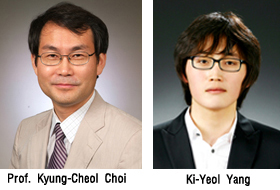 Prof. Choi Unveils Method to Improve Emission Efficiency of OLED
A KAIST research team led by Prof. Kyung-Cheol Choi of the School of Electrical Engineering & Computer Science discovered the surface plasmon-enhanced spontaneous emission based on an organic light-emitting device (OLED), a finding expected to improve OLED"s emission efficiency, KAIST authorities said on Thursday (July 9).
For surface plasmon localization, silver nanoparticles were thermally deposited in a high vacuum on cathode. Since plasmons provide a strong oscillator decay channel, time-resolved photoluninescene (PL) results displayed a 1.75-fold increased emission rate, and continuous wave PL results showed a twofold enhanced intensity.
"The method using surface plasmon represents a new technology to enhance the emission efficiency of OLED. It is expected to greatly contribute to the development of new technologies in OLED and flexible display, as well as securing original technology," Prof. Choi said.
The finding was published in the April issue of Applied Physics Letters and the June 25 issue of Optics Express. It will be also featured as the research highlight of the August issue of Nature Photonics and Virtual Journal of Ultrafast Science.
2009.07.09 View 24378
Prof. Choi Unveils Method to Improve Emission Efficiency of OLED
A KAIST research team led by Prof. Kyung-Cheol Choi of the School of Electrical Engineering & Computer Science discovered the surface plasmon-enhanced spontaneous emission based on an organic light-emitting device (OLED), a finding expected to improve OLED"s emission efficiency, KAIST authorities said on Thursday (July 9).
For surface plasmon localization, silver nanoparticles were thermally deposited in a high vacuum on cathode. Since plasmons provide a strong oscillator decay channel, time-resolved photoluninescene (PL) results displayed a 1.75-fold increased emission rate, and continuous wave PL results showed a twofold enhanced intensity.
"The method using surface plasmon represents a new technology to enhance the emission efficiency of OLED. It is expected to greatly contribute to the development of new technologies in OLED and flexible display, as well as securing original technology," Prof. Choi said.
The finding was published in the April issue of Applied Physics Letters and the June 25 issue of Optics Express. It will be also featured as the research highlight of the August issue of Nature Photonics and Virtual Journal of Ultrafast Science.
2009.07.09 View 24378 -
 U.S. and Korean Researchers Unveil Newest Research Team Member: Jaemi the Humanoid
- Project aims to enable humanoids to interact with people and their environment
June 1, 2009-- A Drexel University-led research team late last week unveiled the newest, most central member of its collaboration with a team of Korean researchers: Jaemi, a humanoid (HUBO). Jaemi HUBO embodies efforts to advance humanoid development and enhance the concept of human-robotic interaction. The project"s goal is to enable humanoids to interact with their environment, and enhancement plans include enabling the humanoid to move over rugged terrain, in unstructured environments and to interact socially with humans and handle objects.
The five-year project, funded through the National Science Foundation (NSF) Partnership for International Research and Education (PIRE) program, seeks transformative models to catalyze discovery through international research collaboration and train U.S. students and junior researchers to effectively think and work in global teams.
"The field of robotics is among the top 10 technology areas considered engines for economic growth. Korea understands this and is aggressively pursuing robotics. To stay competitive, the U.S. must do the same," said Mark Suskin, acting deputy director of NSF"s Office of International Science and Engineering. "NSF"s PIRE program and this robotics collaboration in particular, enable the U.S. to capitalize on research in other countries and remain competitive."
The PIRE research team is composed of researchers at The University of Pennsylvania, Colby College, Bryn Mawr College and Virginia Tech in the United States; and Korea Advanced Institute of Science and Technology (KAIST), Korea University and Seoul National University in Korea.
The team obtained a version of KAIST"s HUBO humanoid, which it named Jaemi HUBO and decided to house it at Drexel University. KAIST HUBO lab has become a model of cutting advance humanoid research by relatively small teams working on tight budgets.
KAIST excels in humanoid leg and body design, biped gait (walking, running, kicking), balance (modeling and control system design), and hardware integration. U.S. robotics researchers tend to enjoy an edge in locomotion over rugged, unstructured terrain; manipulation/grasping; cognition, perception and human-robot interaction; and vision (image, understanding, navigation).
This collaboration of American and Korean researchers will seek to draw on the expertise of each researcher and take Jaemi HUBO to the next level of development--that is, to improve Jaemi"s capabilities to navigate and manipulate objects and interact with people in unstructured environments. Such capabilities demand information technologies like cognition, perception and networking areas. Targeted enhancement features include a capability to move over rugged terrain and in unstructured environments and to handle objects and interact socially with humans.
Jaemi HUBO will also educate the American public, particularly young people, about the science of robotics. This education process began at the Please Touch Museum in Philadelphia on May 28, 2009, when Jaemi HUBO was unveiled and introduced to a crowded audience of children and a few adults. Neither male nor female,Jaemi connected with the children, boys and girls alike. Guided by a Drexel University graduate student, Jamei moved, spoke, danced, shook hands and lead the children in a game of Simon Says. Such access to Jaemi HUBO starkly contrasts with that afforded by other high-profile humanoids that are often protected trade secrets, largely inaccessible to the public.
Museum curators are pleased to have had Jaemi visit and entertain kids during the weekend. "At the Please Touch Museum, we promote learning through a variety of senses," said J. Willard Whitson,the museum"s vice president for exhibits and education. "A humanoid not only embodies our goal of building layers of knowledge in young people, but Jaemi helps all of us celebrate the playful side of technology."
Jaemi HUBO is now at its permanent home at Drexel University, from which travel and guest appearances may be arranged by appointment. Journalists interested in meeting and interviewing Jaemi HUBO and other research team members are encouraged to contact Lisa-Joy Zgorski at lisajoy@nsf.gov. (Press Release of U.S. National Science Foundation)
2009.06.19 View 18503
U.S. and Korean Researchers Unveil Newest Research Team Member: Jaemi the Humanoid
- Project aims to enable humanoids to interact with people and their environment
June 1, 2009-- A Drexel University-led research team late last week unveiled the newest, most central member of its collaboration with a team of Korean researchers: Jaemi, a humanoid (HUBO). Jaemi HUBO embodies efforts to advance humanoid development and enhance the concept of human-robotic interaction. The project"s goal is to enable humanoids to interact with their environment, and enhancement plans include enabling the humanoid to move over rugged terrain, in unstructured environments and to interact socially with humans and handle objects.
The five-year project, funded through the National Science Foundation (NSF) Partnership for International Research and Education (PIRE) program, seeks transformative models to catalyze discovery through international research collaboration and train U.S. students and junior researchers to effectively think and work in global teams.
"The field of robotics is among the top 10 technology areas considered engines for economic growth. Korea understands this and is aggressively pursuing robotics. To stay competitive, the U.S. must do the same," said Mark Suskin, acting deputy director of NSF"s Office of International Science and Engineering. "NSF"s PIRE program and this robotics collaboration in particular, enable the U.S. to capitalize on research in other countries and remain competitive."
The PIRE research team is composed of researchers at The University of Pennsylvania, Colby College, Bryn Mawr College and Virginia Tech in the United States; and Korea Advanced Institute of Science and Technology (KAIST), Korea University and Seoul National University in Korea.
The team obtained a version of KAIST"s HUBO humanoid, which it named Jaemi HUBO and decided to house it at Drexel University. KAIST HUBO lab has become a model of cutting advance humanoid research by relatively small teams working on tight budgets.
KAIST excels in humanoid leg and body design, biped gait (walking, running, kicking), balance (modeling and control system design), and hardware integration. U.S. robotics researchers tend to enjoy an edge in locomotion over rugged, unstructured terrain; manipulation/grasping; cognition, perception and human-robot interaction; and vision (image, understanding, navigation).
This collaboration of American and Korean researchers will seek to draw on the expertise of each researcher and take Jaemi HUBO to the next level of development--that is, to improve Jaemi"s capabilities to navigate and manipulate objects and interact with people in unstructured environments. Such capabilities demand information technologies like cognition, perception and networking areas. Targeted enhancement features include a capability to move over rugged terrain and in unstructured environments and to handle objects and interact socially with humans.
Jaemi HUBO will also educate the American public, particularly young people, about the science of robotics. This education process began at the Please Touch Museum in Philadelphia on May 28, 2009, when Jaemi HUBO was unveiled and introduced to a crowded audience of children and a few adults. Neither male nor female,Jaemi connected with the children, boys and girls alike. Guided by a Drexel University graduate student, Jamei moved, spoke, danced, shook hands and lead the children in a game of Simon Says. Such access to Jaemi HUBO starkly contrasts with that afforded by other high-profile humanoids that are often protected trade secrets, largely inaccessible to the public.
Museum curators are pleased to have had Jaemi visit and entertain kids during the weekend. "At the Please Touch Museum, we promote learning through a variety of senses," said J. Willard Whitson,the museum"s vice president for exhibits and education. "A humanoid not only embodies our goal of building layers of knowledge in young people, but Jaemi helps all of us celebrate the playful side of technology."
Jaemi HUBO is now at its permanent home at Drexel University, from which travel and guest appearances may be arranged by appointment. Journalists interested in meeting and interviewing Jaemi HUBO and other research team members are encouraged to contact Lisa-Joy Zgorski at lisajoy@nsf.gov. (Press Release of U.S. National Science Foundation)
2009.06.19 View 18503 -
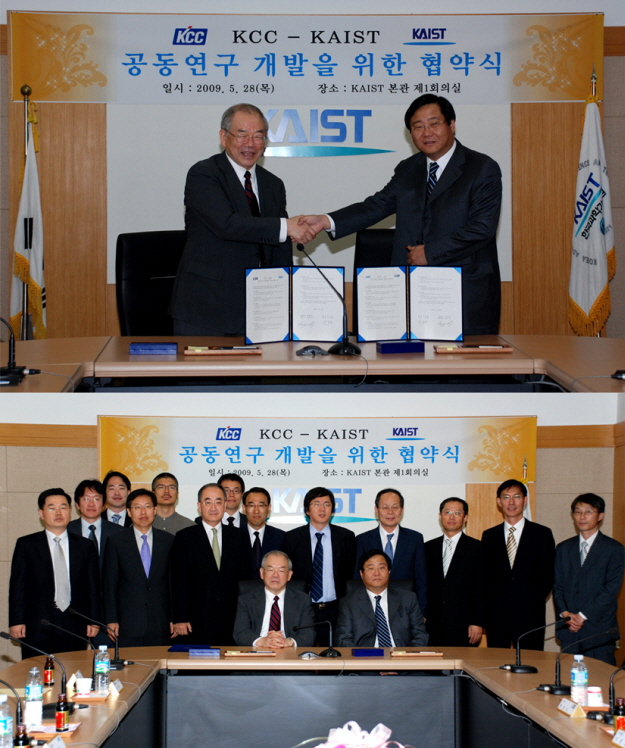 KAIST Signs Agreement for Industry-Academia Cooperation with KCC
KAIST signed an agreement for industry-academia cooperation with KCC, Korea"s leading supplier of building & industrial materials, on May 28, university sources said.
The agreement signed by KAIST President Nam-Pyo Suh and Mong-Jin Chung, Chairman of the KCC Business Group, calls for KAIST and KCC to conduct joint research for the development of new technologies in nano science, new materials areas and interdisciplinary areas.
Under the agreement, KCC will invest 5 billion won into the KAIST Institute for the NanoCentury over the next five years.
KCC Chairman Chung said: "Through this industry-academia cooperation agreement, we are seeking to give part of our profits back to community . We hope this agreement to contribute to the development of core technologies of the future in the new materials field, and nurturing specialized manpower."
2009.05.28 View 16532
KAIST Signs Agreement for Industry-Academia Cooperation with KCC
KAIST signed an agreement for industry-academia cooperation with KCC, Korea"s leading supplier of building & industrial materials, on May 28, university sources said.
The agreement signed by KAIST President Nam-Pyo Suh and Mong-Jin Chung, Chairman of the KCC Business Group, calls for KAIST and KCC to conduct joint research for the development of new technologies in nano science, new materials areas and interdisciplinary areas.
Under the agreement, KCC will invest 5 billion won into the KAIST Institute for the NanoCentury over the next five years.
KCC Chairman Chung said: "Through this industry-academia cooperation agreement, we are seeking to give part of our profits back to community . We hope this agreement to contribute to the development of core technologies of the future in the new materials field, and nurturing specialized manpower."
2009.05.28 View 16532 -
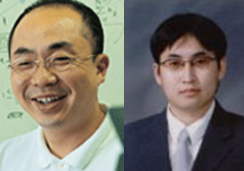 Prof. Chong Unveils New Human Movement Model
A KAIST research team headed by Prof. Song Chong of the School of Electrical Engineering and Computer Science has developed a new statistical model that simulates human mobility patterns, mimicking the way people move over the course of a day, a month or longer, university sources said on Tuesday (May 12).
The model, developed in collaboration with scientists at North Carolina State University, is the first to represent the regular movement patterns of humans using statistical data.
The model has a variety of potential uses, ranging from land use planning to public health studies on epidemic disease.
The researchers gave global positioning system (GPS) devices to approximately 100 volunteers at five locations in the U.S. and South Korea and tracked the participants" movements over time. By tracing the points where the study participants stopped, and their movement trajectories, researchers were able to determine patterns of mobility behavior.
The researchers were then able to emulate these fundamental statistical properties of human mobility into a model that could be used to represent the regular daily movement of humans. The model, called Self-similar Least Action Walk (SLAW), will have a wide array of practical applications.
The research, "SLAW: A Mobility Model for Human Walks," was presented on April 20 at the 28th IEEE Conference on Computer Communications in Rio de Janeiro, Brazil. The National Science Foundation of the U.S. funded the research.
2009.05.13 View 17215
Prof. Chong Unveils New Human Movement Model
A KAIST research team headed by Prof. Song Chong of the School of Electrical Engineering and Computer Science has developed a new statistical model that simulates human mobility patterns, mimicking the way people move over the course of a day, a month or longer, university sources said on Tuesday (May 12).
The model, developed in collaboration with scientists at North Carolina State University, is the first to represent the regular movement patterns of humans using statistical data.
The model has a variety of potential uses, ranging from land use planning to public health studies on epidemic disease.
The researchers gave global positioning system (GPS) devices to approximately 100 volunteers at five locations in the U.S. and South Korea and tracked the participants" movements over time. By tracing the points where the study participants stopped, and their movement trajectories, researchers were able to determine patterns of mobility behavior.
The researchers were then able to emulate these fundamental statistical properties of human mobility into a model that could be used to represent the regular daily movement of humans. The model, called Self-similar Least Action Walk (SLAW), will have a wide array of practical applications.
The research, "SLAW: A Mobility Model for Human Walks," was presented on April 20 at the 28th IEEE Conference on Computer Communications in Rio de Janeiro, Brazil. The National Science Foundation of the U.S. funded the research.
2009.05.13 View 17215 -
 Workshop on Biomedical IC to Be Held on March 26
KAIST will hold a workshop on "biomedical IC for future healthcare system" on March 26 at a lecture room of the School of Electrical Engineering & Computer Science. The workshop is organized by SEECS and the Korean Institute of Next Generation Computing.
At the workshop, a variety of new technologies expected to expedite the development of biomedical systems will be presented. KAIST Prof. Hoi-Jun Yoo will speak on the "body channel communication" using the human body as the signal transmission medium and Dr. Seung-Hwan Kim of Electronics and Telecommunications Research Institute (ETRI) on a wearable vital sign monitoring system.
Other subjects are CMOS (complementary metal-oxide semiconductor) fully electronic biosensor for biomolecular detection to be presented by KAIST Prof. Gyu-Hyeong Cho; nerve interface and IC (integrated circuit) system design by KAIST Prof. Yoon-gi Nam; design of neural recording and stimulation IC using time-varying magnetic field by KAIST Prof. Seong-Hwan Cho; low power multi-core digital signal processor for hearing aid by Dong-Wook Kim, senior researcher at the Samsung Advanced Institute of Technology; and a non-contact cardiac sensor by KAIST Prof. Seung-Chul Hong.
With the advent of the ageing society, medical expenses of the elderly people are rapidly increasing. As a way to address the issue, interests are growing in "ubiquitous healthcare," a technology that uses a large number of environmental and patient sensors and actuators to monitor and improve patients’ physical and mental condition.
The upcoming workshop is the first academic event on biomedical integrated chips to be held in Korea. The workshop will provide a valuable opportunity for experts in biomedical area to get together and examine the present status of Korean biomedical area and discuss about its future, KAIST officials said.
2009.03.20 View 22717
Workshop on Biomedical IC to Be Held on March 26
KAIST will hold a workshop on "biomedical IC for future healthcare system" on March 26 at a lecture room of the School of Electrical Engineering & Computer Science. The workshop is organized by SEECS and the Korean Institute of Next Generation Computing.
At the workshop, a variety of new technologies expected to expedite the development of biomedical systems will be presented. KAIST Prof. Hoi-Jun Yoo will speak on the "body channel communication" using the human body as the signal transmission medium and Dr. Seung-Hwan Kim of Electronics and Telecommunications Research Institute (ETRI) on a wearable vital sign monitoring system.
Other subjects are CMOS (complementary metal-oxide semiconductor) fully electronic biosensor for biomolecular detection to be presented by KAIST Prof. Gyu-Hyeong Cho; nerve interface and IC (integrated circuit) system design by KAIST Prof. Yoon-gi Nam; design of neural recording and stimulation IC using time-varying magnetic field by KAIST Prof. Seong-Hwan Cho; low power multi-core digital signal processor for hearing aid by Dong-Wook Kim, senior researcher at the Samsung Advanced Institute of Technology; and a non-contact cardiac sensor by KAIST Prof. Seung-Chul Hong.
With the advent of the ageing society, medical expenses of the elderly people are rapidly increasing. As a way to address the issue, interests are growing in "ubiquitous healthcare," a technology that uses a large number of environmental and patient sensors and actuators to monitor and improve patients’ physical and mental condition.
The upcoming workshop is the first academic event on biomedical integrated chips to be held in Korea. The workshop will provide a valuable opportunity for experts in biomedical area to get together and examine the present status of Korean biomedical area and discuss about its future, KAIST officials said.
2009.03.20 View 22717 -
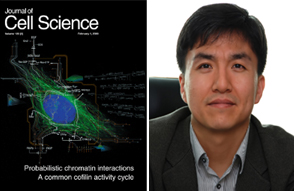 Prof. Cho Identifies Dynamics of Signal Transportation System in Control of Cell Proliferation
KAIST, Jan. 22, 2009 -- A research team led by Prof. Kwang-Hyun Cho of the Department of Bio and Brain Engineering, KAIST, has identified a hidden mechanism of the dynamic behavior of signal transportation system involved in the control of cell proliferation, university authorities said.
The finding is expected to provide a clue to appropriately controlling the pathway of ERK protein which is known to play a significant role in causing and spreading cancer. The research was featured as the cover paper of the latest online edition of the Journal of Cell Science.
The Ras-Raf-MEK-ERK pathway (or ERK pathway) is an important signal transduction system involved in the control of cell proliferation, survival and differentiation. However, the dynamic regulation of the pathway by positive- and negative-feedback mechanism, in particular the functional role of Raf kinase inhibitor protein (RKIP) are still incompletely understood. RKIP is a physiological endogenous inhibitor of MEK phosphorylation by Raf kinases, but also participates in a positive-feedback loop in which ERK can inactivate RKIP.
"We attempted to unearth the hidden dynamics of these feedback mechanisms and to identify the functional role of RKIP through combined efforts of biochemical experiments and computer simulations based on an experimentally validated mechanical model," Prof. Cho was quoted as saying.
2009.02.03 View 14888
Prof. Cho Identifies Dynamics of Signal Transportation System in Control of Cell Proliferation
KAIST, Jan. 22, 2009 -- A research team led by Prof. Kwang-Hyun Cho of the Department of Bio and Brain Engineering, KAIST, has identified a hidden mechanism of the dynamic behavior of signal transportation system involved in the control of cell proliferation, university authorities said.
The finding is expected to provide a clue to appropriately controlling the pathway of ERK protein which is known to play a significant role in causing and spreading cancer. The research was featured as the cover paper of the latest online edition of the Journal of Cell Science.
The Ras-Raf-MEK-ERK pathway (or ERK pathway) is an important signal transduction system involved in the control of cell proliferation, survival and differentiation. However, the dynamic regulation of the pathway by positive- and negative-feedback mechanism, in particular the functional role of Raf kinase inhibitor protein (RKIP) are still incompletely understood. RKIP is a physiological endogenous inhibitor of MEK phosphorylation by Raf kinases, but also participates in a positive-feedback loop in which ERK can inactivate RKIP.
"We attempted to unearth the hidden dynamics of these feedback mechanisms and to identify the functional role of RKIP through combined efforts of biochemical experiments and computer simulations based on an experimentally validated mechanical model," Prof. Cho was quoted as saying.
2009.02.03 View 14888 -
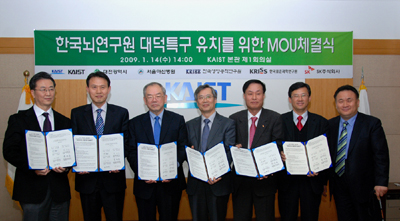 Six Organizations Join Forces to Induce Projected National Brain Institute to Daejeon
Six major organizations including KAIST have joined forces to help Daejeon City to win the government approval to build the envisioned Korean Brain Institute in Daedeok Research Complex.
The six organizations signed a memorandum of understanding on cooperating in establishing the government-funded institute built within the Daedeok Research Complex in the city of Daejeon, at KAIST on Jan. 14. The six organizations are KAIST, the Daejeon City Government, Korea Research Institute of Bioscience and Biotechnology, Korea Research Institute of Standard and Science, Asan Medical Center, and SK Corp., a pioneer in effective therapeutic invention for serious brain disorders.
The partnership of the six organizations is expected to bring a broad-based cooperation opportunities and create a massive synergy effect in the brain science researches and the development of new therapeutic treatment for brain disorders by combining their resources and infrastructures.
The six organizations have also built an international research network with such globally-renowned brain research institutions as RIKEN, a large natural sciences research institute in Japan, Max Plank Institute in Germany, Federal Institute of Technology, Lausanne, in Switzerland and Brain Research Institute of University of Queensland in Australia. The research network is under the support and guidance of Dennis Choi, a prominent neuroscientist who once served as the President of the Society for Neuroscience and is currently a professor in the Departments of Neurology and biology at Emory University.
The tentatively titled Korea Brain Institute is envisioned to help fight brain disorders and create Korea"s new growth engine, as well as lengthening life span, by conducting convergence researches in nero science, brain science and pharmacology. If the consortium of the six organizations wins the government approval to build the proposed institute within the Daedeok complex, the central government and the Daejeon city government are expected to pour a total of 329.7 billion won into the project by 2020.
2009.01.14 View 21981
Six Organizations Join Forces to Induce Projected National Brain Institute to Daejeon
Six major organizations including KAIST have joined forces to help Daejeon City to win the government approval to build the envisioned Korean Brain Institute in Daedeok Research Complex.
The six organizations signed a memorandum of understanding on cooperating in establishing the government-funded institute built within the Daedeok Research Complex in the city of Daejeon, at KAIST on Jan. 14. The six organizations are KAIST, the Daejeon City Government, Korea Research Institute of Bioscience and Biotechnology, Korea Research Institute of Standard and Science, Asan Medical Center, and SK Corp., a pioneer in effective therapeutic invention for serious brain disorders.
The partnership of the six organizations is expected to bring a broad-based cooperation opportunities and create a massive synergy effect in the brain science researches and the development of new therapeutic treatment for brain disorders by combining their resources and infrastructures.
The six organizations have also built an international research network with such globally-renowned brain research institutions as RIKEN, a large natural sciences research institute in Japan, Max Plank Institute in Germany, Federal Institute of Technology, Lausanne, in Switzerland and Brain Research Institute of University of Queensland in Australia. The research network is under the support and guidance of Dennis Choi, a prominent neuroscientist who once served as the President of the Society for Neuroscience and is currently a professor in the Departments of Neurology and biology at Emory University.
The tentatively titled Korea Brain Institute is envisioned to help fight brain disorders and create Korea"s new growth engine, as well as lengthening life span, by conducting convergence researches in nero science, brain science and pharmacology. If the consortium of the six organizations wins the government approval to build the proposed institute within the Daedeok complex, the central government and the Daejeon city government are expected to pour a total of 329.7 billion won into the project by 2020.
2009.01.14 View 21981 -
 Five KAIST Students Offered Internship from Qualcomm
Qualcomm Inc., a wireless telecommunications research and development company based in San Diego, California, has offered internship for five KAIST students of the Department of Electrical Engineering and Computer Science, university authorities said on Monday (Jan. 5).
The five students who are graduate and doctoral students studying communication and RFID (radio frequency identification) design will be working for six months at Qualcomm"s RFIC (radio frequency integrated circuits) Department in Santa Clara, Calif., as co-researchers. These interns will receive about $7,000 a month each with other benefits.
It is the first time that Qualcomm has offered internship for students outside the U.S., according to external relations officials at KAIST. Students who have shown outstanding research output during the internship period will be offered employment at Qualcomm.
"Qualcomm"s internship for KAIST students is designed to help young Korean talents to become professionals who will lead global advancement in the IT sector and strengthen its research network with Korea," Seung-Soo Kim, senior director of Qualcomm Korea, was quoted as saying.
Qualcomm plans to continue providing internship program for KAIST students, as well as pursuing joint research initiatives, the officials said.
2009.01.08 View 18925
Five KAIST Students Offered Internship from Qualcomm
Qualcomm Inc., a wireless telecommunications research and development company based in San Diego, California, has offered internship for five KAIST students of the Department of Electrical Engineering and Computer Science, university authorities said on Monday (Jan. 5).
The five students who are graduate and doctoral students studying communication and RFID (radio frequency identification) design will be working for six months at Qualcomm"s RFIC (radio frequency integrated circuits) Department in Santa Clara, Calif., as co-researchers. These interns will receive about $7,000 a month each with other benefits.
It is the first time that Qualcomm has offered internship for students outside the U.S., according to external relations officials at KAIST. Students who have shown outstanding research output during the internship period will be offered employment at Qualcomm.
"Qualcomm"s internship for KAIST students is designed to help young Korean talents to become professionals who will lead global advancement in the IT sector and strengthen its research network with Korea," Seung-Soo Kim, senior director of Qualcomm Korea, was quoted as saying.
Qualcomm plans to continue providing internship program for KAIST students, as well as pursuing joint research initiatives, the officials said.
2009.01.08 View 18925 -
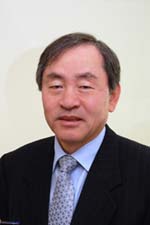 Prof. Cho Wins Best Paper Award
KAIST Prof. Nam-Zin Cho of the Department of Nuclear and Quantum Engineering, won the Best Thesis Award in the nuclear reactor physics category at the 2008 Winter Meeting of the American Nuclear Society held on Nov. 9-13 in Reno, Nevada.
His paper, entitled "Thermal Feedback Transient Analysis of a Pebble Fuel Based on the Two-Temperature Homogenized Model," was jointly authored by Hwi Yu and Jong-Un Kim under the guidance of Prof. Cho.
Prof. Cho was elected a fellow of the American Nuclear Society in 2001 and has served as the deputy editor of the Nuclear Science and Engineering, the research journal of the American Nuclear Society, since 1999.
2008.12.09 View 18383
Prof. Cho Wins Best Paper Award
KAIST Prof. Nam-Zin Cho of the Department of Nuclear and Quantum Engineering, won the Best Thesis Award in the nuclear reactor physics category at the 2008 Winter Meeting of the American Nuclear Society held on Nov. 9-13 in Reno, Nevada.
His paper, entitled "Thermal Feedback Transient Analysis of a Pebble Fuel Based on the Two-Temperature Homogenized Model," was jointly authored by Hwi Yu and Jong-Un Kim under the guidance of Prof. Cho.
Prof. Cho was elected a fellow of the American Nuclear Society in 2001 and has served as the deputy editor of the Nuclear Science and Engineering, the research journal of the American Nuclear Society, since 1999.
2008.12.09 View 18383 -
 KAIST Collaborating with U.S. Universities to Advance Humanoid Robotics
Hubo, a life-size walking bipedal humanoid robot, is perhaps the best-known character in Korea that KAIST has ever produced. It was shown to the government heads of the Asia-Pacific region during the APEC held in Busan, Korea, in 2005 and appeared at the hit concerts of the pop singer Jang-Hoon Kim. The humanoid robot is soon likely to catch the fancy of Americans as a U.S. government-funded project seeks to create a Hubo that can work and interact with people in collaboration with Korean scientists.
"We are going to give the brains to Hubo. (Japanese) Asimo can do only pre-programmed actions. We want to create a Hubo that can help people, interact with people," said Prof. Paul Oh of the Department of Mechanical Engineering & Mechanics at Drexel University in Philadelphia and leader of the five-year international project which was launched in November 2007.
The U.S.$2.5 million project is funded through the Partnership for International Research and Education (PIRE) Program of the National Science Foundation (NSF) of the United States. It brings together world-renowned experts in humanoid design and information technologies.
"Dr. Jun-Ho Oh"s lab at KAIST (that has created Hubo) is the world"s leader in humanoid design and the U.S. has advanced technologies in the areas such as artificial intelligence, mechanical learning and robot vision. Combining the strengths of the two countries can create a synergy effect and develop a more advanced humanoid robot," said Paul Oh. He is currently serving as Program Director of Robotics of the NSF which is overseeing robotics research (non-military) in the U.S. consisting over 150 robotics faculty.
Paul Oh"s research team consists of experts from five U.S. universities -- Drexel, Bryn Mawr College, Colby College, the University of Pennsylvania and Virginia Tech -- and KAIST.
Leading a delegation of six professors and eight students, Dr. Paul Oh made a two-day visit to KAIST on Nov. 18-19 to review the progress of the project and have a technical meeting with participants.
"The U.S. universities participating in this program are scattered across the nation. So we decided to have a technical meeting here in Korea," he said.
Asked the reason why he chose KAIST as a partner for the program, Dr. Oh said that KAIST is willing to open Hugo to international researchers, whereas in Japan only Honda engineers are allowed to touch Asimo, which is a humanoid robot created by Honda Motor Company.
The project is to establish no barrier for roboticists anywhere in the world to pursue the humanoid research; a suite of humanoid platforms will be available for researchers to develop and advance capabilities like locomotion and human-robot interaction.
The team has been initially involved in development of three tools, all of which are based on the Hubo platform, in order to kick-start humanoid research in the U.S. They are the Mini-Hubo (a small, light-weight and affordable humanoid purchasable at the price lower than $8,000), On-Line Hubo (a program to operate Hubo online) and Virtual Hubo (a simulation program to do researches in cyberspace). As the first outcome of the project, the Mini-Hubo is expected to be released in the U.S. around next April.
Another important purpose of the PIRE program is to seek transformative models to train scientists and engineers to effectively work in global multi-disciplined design teams. To this end, an aggregate number of 20 students from U.S. universities are to stay at the KAIST during the next five years, with two students taking turns on a six-month term.
"I was really amazed how much work is done with small funding here. This is really an excellent example to learn," said Roy Gross, an undergraduate from Drexel who has been staying at Prof. Oh"s Lab for the past three months.
2008.11.21 View 23297
KAIST Collaborating with U.S. Universities to Advance Humanoid Robotics
Hubo, a life-size walking bipedal humanoid robot, is perhaps the best-known character in Korea that KAIST has ever produced. It was shown to the government heads of the Asia-Pacific region during the APEC held in Busan, Korea, in 2005 and appeared at the hit concerts of the pop singer Jang-Hoon Kim. The humanoid robot is soon likely to catch the fancy of Americans as a U.S. government-funded project seeks to create a Hubo that can work and interact with people in collaboration with Korean scientists.
"We are going to give the brains to Hubo. (Japanese) Asimo can do only pre-programmed actions. We want to create a Hubo that can help people, interact with people," said Prof. Paul Oh of the Department of Mechanical Engineering & Mechanics at Drexel University in Philadelphia and leader of the five-year international project which was launched in November 2007.
The U.S.$2.5 million project is funded through the Partnership for International Research and Education (PIRE) Program of the National Science Foundation (NSF) of the United States. It brings together world-renowned experts in humanoid design and information technologies.
"Dr. Jun-Ho Oh"s lab at KAIST (that has created Hubo) is the world"s leader in humanoid design and the U.S. has advanced technologies in the areas such as artificial intelligence, mechanical learning and robot vision. Combining the strengths of the two countries can create a synergy effect and develop a more advanced humanoid robot," said Paul Oh. He is currently serving as Program Director of Robotics of the NSF which is overseeing robotics research (non-military) in the U.S. consisting over 150 robotics faculty.
Paul Oh"s research team consists of experts from five U.S. universities -- Drexel, Bryn Mawr College, Colby College, the University of Pennsylvania and Virginia Tech -- and KAIST.
Leading a delegation of six professors and eight students, Dr. Paul Oh made a two-day visit to KAIST on Nov. 18-19 to review the progress of the project and have a technical meeting with participants.
"The U.S. universities participating in this program are scattered across the nation. So we decided to have a technical meeting here in Korea," he said.
Asked the reason why he chose KAIST as a partner for the program, Dr. Oh said that KAIST is willing to open Hugo to international researchers, whereas in Japan only Honda engineers are allowed to touch Asimo, which is a humanoid robot created by Honda Motor Company.
The project is to establish no barrier for roboticists anywhere in the world to pursue the humanoid research; a suite of humanoid platforms will be available for researchers to develop and advance capabilities like locomotion and human-robot interaction.
The team has been initially involved in development of three tools, all of which are based on the Hubo platform, in order to kick-start humanoid research in the U.S. They are the Mini-Hubo (a small, light-weight and affordable humanoid purchasable at the price lower than $8,000), On-Line Hubo (a program to operate Hubo online) and Virtual Hubo (a simulation program to do researches in cyberspace). As the first outcome of the project, the Mini-Hubo is expected to be released in the U.S. around next April.
Another important purpose of the PIRE program is to seek transformative models to train scientists and engineers to effectively work in global multi-disciplined design teams. To this end, an aggregate number of 20 students from U.S. universities are to stay at the KAIST during the next five years, with two students taking turns on a six-month term.
"I was really amazed how much work is done with small funding here. This is really an excellent example to learn," said Roy Gross, an undergraduate from Drexel who has been staying at Prof. Oh"s Lab for the past three months.
2008.11.21 View 23297